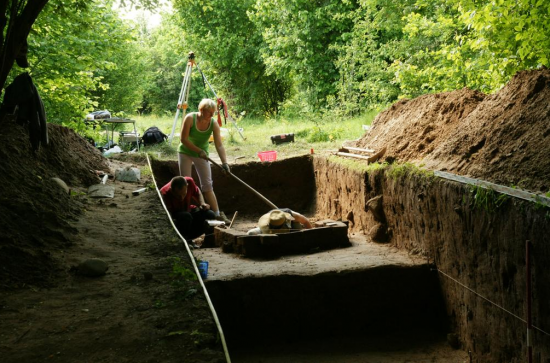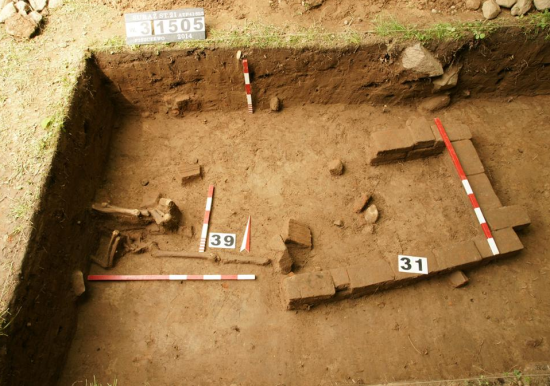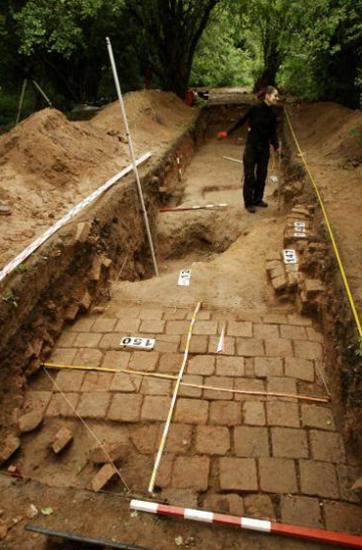PAP - Science and Scholarship in Poland
Source - http://www.naukawpolsce.pap.pl/en/news/news,401376,medieval-church-discovered-in-podlasie.html

Crypt in natural embankment. Photo by D. Krasnodębski
Remnants of the late medieval church have been discovered in the range Piszczewo near Suraż by a team of archaeologists from the Institute of Archaeology and Ethnology PAS in Warsaw.
"During this year's work we were able to discover yet another unknown card in the history of one of the oldest towns in Podlasie. On a small hill on the river Narew, we syrveyed the remains of a sixteenth-century church" - reported Dariusz Krasnodębski of the Institute of Archaeology and Ethnology PAS.
Archaeologists conducted excavations at the site based on inconclusive information derived from written sources and oral reports from the 1930s. According to Krasnodębski, they mentioned the oldest Suraż parish church, which the authorities ordered to dismantle overnight and move to the location of the current parish church at the market square.
"The results of archaeological work have confirmed the part of the legend that mentioned the existence of the church. They also supplemented it significantly by adding completely unknown facts" - said the archaeologist.
It turned out - explained the scientist - that there were probably two buildings in the range, the remains of which point to uses other than residential. In the place of the first one, on the surface of earth an elevation was left with height of up to 1 m, measuring approximately 30 x 20 m. In the elevation, archaeologists found fragments of bricks and more than 500 iron nails.
"We believe that this place was the location of the wooden church, which was dismantled and moved to another location. What remains are fragments of destroyed stone foundations and nails removed from timber beams" - believes Krasnodębski.
In addition to the remains of the church, the researchers discovered a fragment of damaged brick crypt, next to which lay a human skeleton. According to archaeologists, the crypt could be made during the development of the elevation for the church, but the burial is associated with an unspecified dramatic event of later times. This is indicated by a round bullet hole in the skull, visible just above the temple.

Destroyed crypt and part of the skeleton found in the elevation (the one containing 500 nails). Photo by D. Krasnodębski
A few dozen meters further east from the alleged remains of the church, archaeologists stumbled upon more structures. Discovered fragments of hand-made bricks with distinctive recesses embossed by their manufacturers, clearly indicated medieval origins. In the rubble, archaeologists found dozens of pieces of earthenware stove tiles, including beautifully ornamented multicolour tile panels and brick tiles similar to those forming the floor, but decorated with geometric ornament.

Floor of one of the exposed structures. Photo by D. Krasnodębski
After removing the debris, archaeologists saw clay floor, laid with fired tiles, and semi-circular structure built with bricks. A few meters away they found a corner of a brick foundation. Archaeologists speculate that it could be a small chapel and residential building - both structures had defensive qualities.

Fragment of stone foundations of a brick building. Photo by D. Krasnodębski
"These findings shed new light on our knowledge of the past of this part of Podlasie. What we have here is both one of the oldest brick and stone buildings, as well as archaeologically confirmed existence of temple or chapel separate from the town Suraż" - said Krasnodębski.
According to the researchers, the origins of the sanctuary may be associated with the acquisition of the land in the beginning of the 15th century by the Grand Duke Vytautas, who did not want to build his residence in a Slavic settlement, and therefore he founded a church off the beaten track. This allowed him to control both the transport of goods floated down the river Narew, as well as the actions of not necessarily friendly local population. Vytautas’ decision could be prompted by the fact of the Suraż castle having been captured and burned by the Teutonic Knights in 1392. It is possible that he did not want to build his residence and a temple at the freshly burnt site. Further research is needed to confirm this hypothesis, which will take place after obtaining funds for that purpose next year - said Krasnodębski.
This year's excavations were conducted in June and July, with financial support of the Ministry of Science and Higher Education under the National Programme for the Development of Humanities. Activities in Suraż were launched last year with the study of the castle town on the so-called Mount Queen Bona. It yielded the discovery of the fortifications from the 10th-17th century.